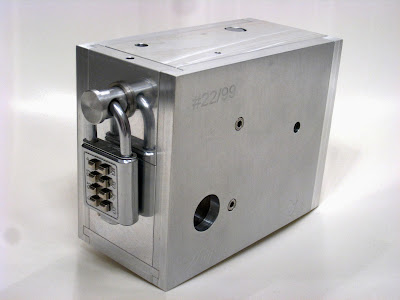Name
Conjuring Conundrum
Designers
Allard Walker and
Louis Coolen. Allard runs his own puzzle blog
Puzzling Times.
Manufacturer
Allard Walker and Louis Coolen. Available now only from
Wil Strijbos for 48 Euros. Please PM me via my blog profile email if you do not have Wil's contact details.
Type & Classification
Sequential Discovery; 2D Assembly
Dimensions
10cm (length) x 7cm (Width) x 1.8cm (Height)
Materials & Construction
The puzzle is made up of a combination of materials including aluminium, steel, fabric and acrylic. The miniature briefcase (for business cards) is commercially available. The insides are actually very decently "modded" by hand, considering there is a fair amount of cutting and glueing. Comes packaged in a cardboard box with the IPP33 logo and text bearing both designers' names. Accompanied by a sealed solution sheet. For a very interesting account of how Allard and Louis created and produced the Conjuring Conundrum, click
here.
IPP
The Conjuring Conundrum was Allard's
Exchange Puzzle at
IPP33 in Tokyo, Japan just this past August.
 |
| The briefcase with all its contents out (well, almost all) |
Overview
I met puzzle collector and blogger Allard Walker the first time in person at IPP33 outside the lobby of the hotel where event was held. He looks better in person than the photograph on his blog profile. I had corresponded with Allard from time to time via email over the last couple of years (usually asking him for his opinion on a certain puzzle or for help in solving etc) prior to our meeting. We were both part of a
group that took a trip into Tokyo city to look for some Karakuri puzzles. I have never met Louis but from what I have heard, he is a master solver, solving puzzles sometimes in minutes when others may take hours, days or months.
I was an Exchange Assistant (to puzzle collector Diniar Namdarian) at IPP33 and assistants typically only assist and do not get any exchange puzzles. Nonetheless Allard was very kind to give me a copy of his Conjuring Conundrum as a gift (thank you Allard). He told me a story of how
Peter Wiltshire had given him (Allard) an exchange puzzle when Allard himself was an exchange assistant, and encouraged me to pass on this tradition when I myself one day become a puzzle exchanger, which hopefully will be soon.
The Conjuring Conundrum is actually two puzzles in one. The first puzzle is to open the briefcase. Step one is very easy...just undo the latches like any other normal briefcase as you would. Then the tough part comes. The lid of the case can only open a little bit enough for you to take a peek inside. There are things inside that look rather confusing and messy.
This is a sequential discovery puzzle so Allard and Louis have provided certain "tools" for use in opening the case. I fiddled with the case and studied whatever I could see inside. I was surprise to find myself quite quick to figure the way to opening the case lid. Very good use of the tools provided and clever execution of the mechanism I might add. Actually just opening the lid of the briefcase itself would already have made a pretty good puzzle, but Allard and Louis went further...
Having opened up the case, I found a fabric cloth bag containing a number of irregular shaped pieces of white acrylic. A little instruction card came with it; the object (of this second puzzle) is to form a shape of some sort using the pieces provided, on the back cover of the briefcase as a working surface. ie 2D assembly.
While Allard later told me that opening the brief case was the hard part, I have to disagree. Arranging the acrylic pieces to form the intended shape was to me the more difficult of the two. In fact so difficult for me that I had to ask Allard for help.
I got nowhere with his initial clues and after a long time trying, my patience ran out and I checked the solution. The solution was just as cryptic as Allard's clues and again I emailed Allard for help. Finally he gave me the intended position of two of the pieces and I was on my way again. After some more pushing the pieces around, I eventually solved the second puzzle and got the shape required, well more or less at least, although not fully complete...whew! I am glad that I was not the only one who had problems with the second puzzle. Apparently puzzle blogger
Kevin Sadler was also stumped by the pieces in the bag.
Update 1 Nov 2013 - I was encouraged by Allard and Louis to try to (fully) complete the 2D assembly (packing) puzzle so I took it out of my puzzle cabinet to have another go at it...discovered the final solution after 10mins. All the time it was actually there "staring" at me in the face! Really unexpected trick...unusual twist for a 2D packing puzzle!!
Difficulty Level
Overall a difficult puzzle in my opinion, both the first and second parts, especially for those who have not much experience with sequential discovery type puzzles. Personally I found the second challenge far more difficult than the first, maybe because I am much better at sequential discovery puzzles as opposed to packing ones which I am crap at.
Summary
Great puzzle and certainly good value for money since you are getting two puzzles in one. For a sequential discovery puzzle, a rather unique and very clever trick incorporated within. And something for those who also happen to like packing puzzles.


























